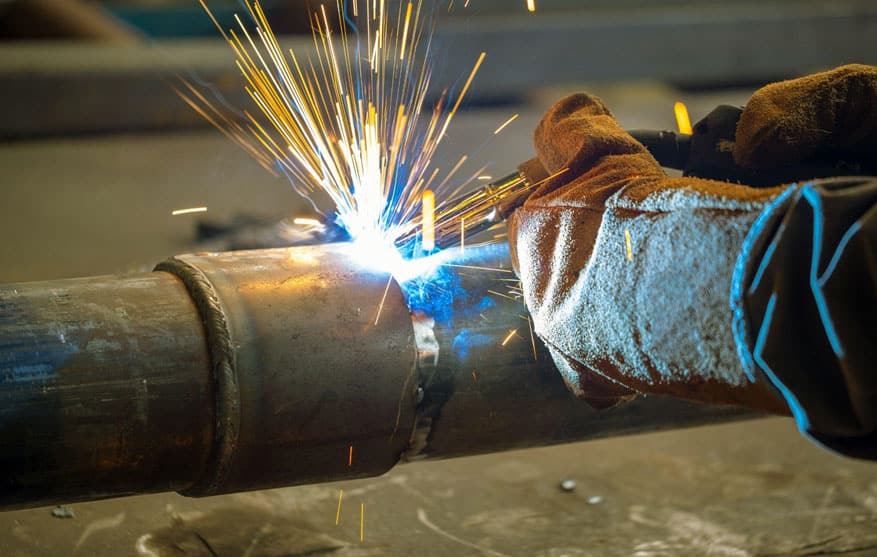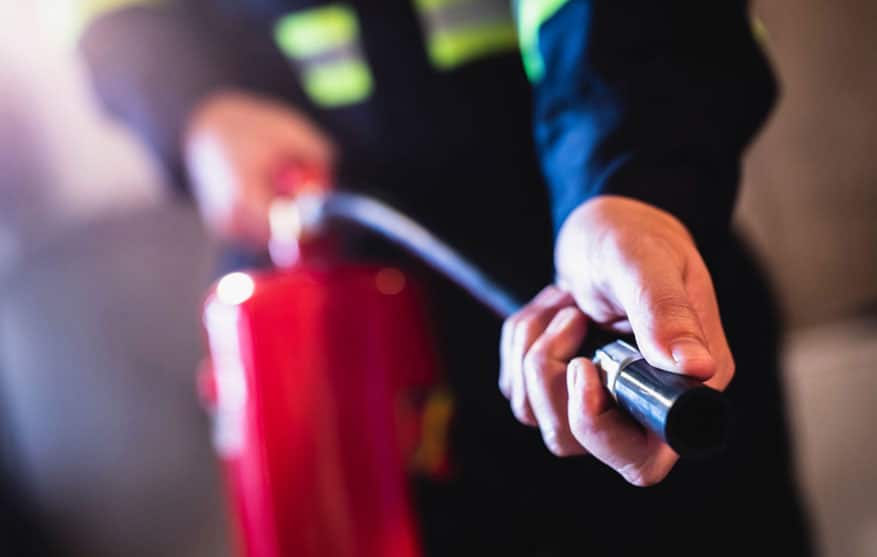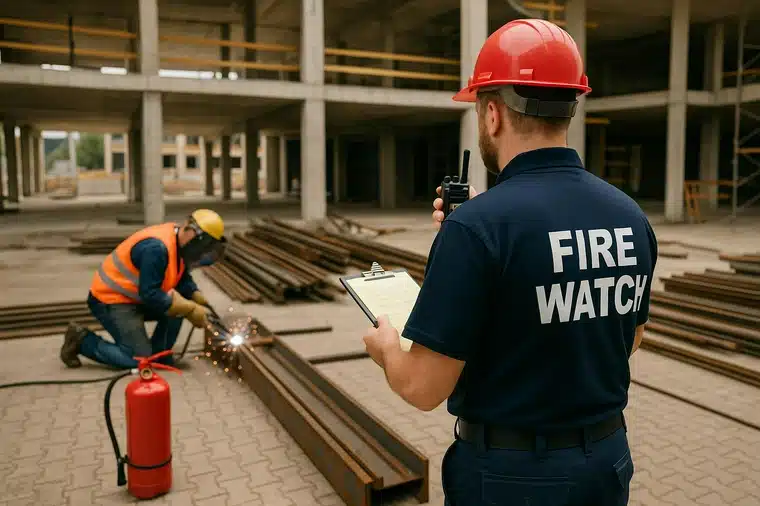Welding and cutting are the lifeblood of many industries—whether you’re building skyscrapers, repairing pipelines, or fabricating metalwork.
But alongside the sparks, heat, and slag comes a serious risk – you guessed it -fire.
That’s where a fire watch comes in.
According to the U.S. Bureau of Labor Statistics, welding accidents cause 500,000 injuries every year. Many of these incidents involve preventable fires that could have been stopped before they spread.
When sparks from your welding torch meet combustible materials, you’re not just looking at a small flame – you’re potentially facing property damage, injuries, and serious OSHA violations.
This article will walk you through what OSHA and NFPA regulations say, why fire watches matter, and how you can stay safe and compliant without overcomplicating things.
What You’ll Learn:
- When OSHA and NFPA require a fire watch – The specific conditions that trigger mandatory fire watch requirements
- How long must the fire watch stay – During welding operations and the critical post-work monitoring period
- Who can legally serve as a fire watch – Training requirements and why your welder can’t do both jobs
- Professional vs. in-house fire watch – When it makes sense to bring in specialists
Fire Watch for Hot Work: The Basics
A fire watch is a dedicated safety person whose only job is to watch for fires during and after welding operations. They’re not there to help with the welding, answer phone calls, or multitask—their sole focus is spotting sparks, flames, or anything that could turn into a bigger problem.
Here’s Why This Matters
The person doing the welding can’t also be the fire watch. When you’re concentrating on laying down a perfect bead or making a critical cut, you’re not scanning the area for stray sparks that might have landed on a piece of cardboard 20 feet away. Your attention is on the work, as it should be.
A fire watch person needs to be positioned where they can see the entire work area, including spaces above, below, and on the opposite side of walls where heat might travel.
They’re equipped with fire extinguishers and have the authority to stop work immediately if they spot a hazard.
| 🔥Real-world example: A welder is working on a structural beam in a building under construction. Sparks are flying, some landing on sawdust that accumulated near a doorway two floors below. The welder never sees this, but a properly positioned fire watch does—and puts out what could have become a serious incident. |
Many companies try to assign fire watch as an “extra duty” to someone who’s already doing another job.
This approach doesn’t work.
Fire watch isn’t a task you can squeeze in between other duties—it requires complete attention and specialized training, which is why dedicated specialists often make the difference between a safe job and a costly incident.
Why Is a Fire Watch So Important in Welding?

Welding generates sparks, heat, and molten slag that can fly off in unpredictable directions. Even a single spark can ignite dust, wood, paper, or insulation—especially in older buildings, tight spaces, or construction zones.
Fires from hot work are more common than most people think. According to the NFPA, hot work is responsible for thousands of structure fires every year, many of which could have been prevented with a proper fire watch in place.
Fire watch personnel aren’t just there in case something goes wrong — they’re there to make sure it doesn’t.
They’re trained to:
- Identify ignition risks on the spot
- Use fire extinguishers and other firefighting tools
- Sound alarms and coordinate evacuation if needed
- Maintain a fire log and stay alert after the work ends
When Is a Fire Watch Required Around Welding and Cutting Operations?
According to OSHA regulations (specifically 29 CFR 1910 Subpart Q) and NFPA 51B (the Standard for Fire Prevention During Welding, Cutting, and Other Hot Work), a fire watch is required any time hot work is being performed in areas where fire hazards exist.
Let’s get more specific.
Combustible materials are within 35 feet of the welding or cutting area
If there are wood, cardboard, flammable liquids, or even paper dust nearby—and you can’t move or shield them effectively—you’ll need a fire watch on duty.
Combustibles are on the other side of walls, ceilings, or floors
Heat can transfer through barriers and ignite hidden materials. If you’re working near partitions, false ceilings, or double-layered walls, the risk increases.
Openings nearby lead to combustible areas
Are there holes, vents, ducts, or stairwells within 35 feet? Sparks can travel through them and reach flammable materials, even in different rooms or floors.
Combustible materials are below the work area
Welding on scaffolding or mezzanines? Slag or sparks can fall through grates or gaps and land on something flammable underneath.
Sparks and slag are likely to fall
If the nature of the hot work generates falling debris (common in vertical welding or overhead jobs), a fire watch is necessary.
Professional fire watch services are familiar with these nuances and can quickly assess whether your specific job site triggers any of these conditions, helping you stay compliant.
How Long Does the Fire Watch Stay?
Here’s where things get interesting—and where many companies make costly mistakes.
During Active Welding Operations
While welding is happening, your fire watch needs to be continuously present and alert. No stepping away for phone calls, no quick trips to grab supplies, no “just watching from the truck.”
OSHA is crystal clear: the fire watch must maintain continuous observation throughout the entire hot work operation.
If your fire watch needs to leave for any reason—even a bathroom break—welding stops until a qualified replacement takes over. This isn’t overkill; it’s recognizing that fires can start in seconds.
How Long Is a Fire Watch Needed After Welding?
| 🕒 OSHA: Minimum 30 minutes OSHA requires a fire watch to stay on site for at least 30 minutes after the hot work ends. |
Once welding stops, your fire watch isn’t done. OSHA requires fire watch personnel to remain on site for at least 30 minutes after hot work completion.
This isn’t arbitrary—it’s based on real incidents where materials smoldered for extended periods before igniting.
Here’s what can happen during those crucial 30 minutes:
- Sparks embedded in insulation or hidden crevices finally reach ignition temperature
- Hot slag continues to burn through protective coverings
- Metal components stay hot enough to ignite nearby materials
- Welding fumes settle and create delayed ignition risks
While OSHA sets 30 minutes as the minimum, many experienced professionals recommend more extended monitoring periods. The NFPA suggests that fire monitoring should continue for up to 3 additional hours in certain high-risk situations, especially when:
- Working in confined spaces with limited ventilation
- Welding near highly combustible materials
- Operating in older buildings with hidden combustibles
- Dealing with complex structures where sparks could travel unseen
Savvy project managers often extend fire watch beyond the minimum requirements, especially on critical projects where a fire would cause major delays or safety issues.
Hidden Fire Hazards During Cooldown
The post-welding period is when fires often start in places you’d never expect:
- Openings around pipes extending through floors or walls
- Concealed spaces with combustible insulation
- Gaps in fire barriers that allow heat transfer
- Equipment with combustible internal linings
- Conveyor systems that can carry smoldering materials
What Industries Need Fire Watch for Welding?
You might think fire watch only applies to major industrial jobs, but these regulations apply broadly.
Industries that often require fire watch services:
- Construction
- Manufacturing & fabrication
- Shipbuilding & maritime
- Refineries and chemical plants
- Commercial renovations
- Warehousing & distribution centers
Even temporary hot work in places like schools, hospitals, or office buildings can trigger a fire watch requirement.
Who Can Serve as a Fire Watch for Welding Operations?

Per OSHA and NFPA, the fire watch must be trained and competent.
A fire watch guard should be trained in:
- Hot work safety protocols
- Fire extinguisher use
- Emergency response
- Site documentation
- Maintaining alertness across extended periods
If your team isn’t fully trained and designated for that duty, it’s time to bring in professionals.
Why Choose Fast Fire Watch Guards?
If you manage hot work anywhere in the U.S., we can be your reliable and responsive partner in meeting fire watch requirements.
While we’re not here to hard sell, here’s why many companies choose us:
✓ Same-Day Dispatch: Guards often arrive in under 3 hours
✓ Trained for Hot Work Hazards: We specialize in welding, cutting, and related operations
✓ Fire Log Documentation: We maintain records to support your safety audits
✓ Nationwide Service: No matter where your project is located, we’ve got you covered
✓ Led by a Former Firefighter: Our CEO, Noah Navarro, brings 16+ years of real-world experience
The Business Case for Professional Fire Watch Services
When you compare the cost of professional fire watch services to the potential cost of a welding fire incident, the math is straightforward.
A single fire can shut down an entire construction project, damage expensive equipment, trigger insurance investigations, and result in OSHA fines reaching tens of thousands of dollars.
Professional fire watch services understand welding-specific hazards like slag travel patterns, heat transfer through metal structures, and the unique risks of different welding processes.
They carry proper liability insurance and can deploy trained personnel to your site quickly, often within hours, when your welding schedule changes.
For project managers juggling tight deadlines, professional fire watch eliminates the logistics nightmare of pulling workers off other tasks, having someone actually show up for extended monitoring periods, and dealing with the liability of using untrained personnel.
Want peace of mind, regulatory compliance, and a smoother job site?
Contact Fast Fire Watch Guards today for reliable, professional fire watch coverage.
Or learn more about our Expert Hot Work Fire Watch Services
Your welding crew stays focused on welding while our specialists handle fire prevention.
